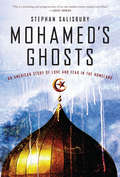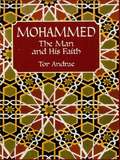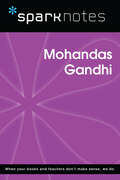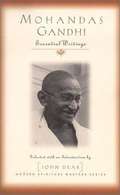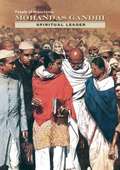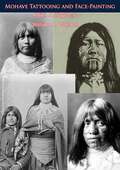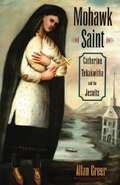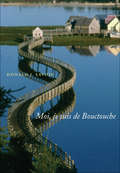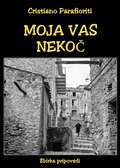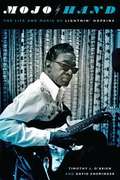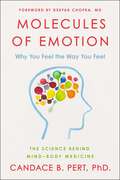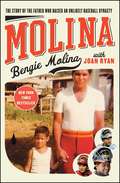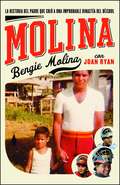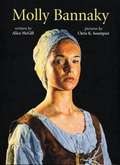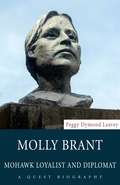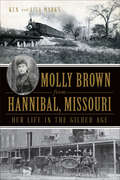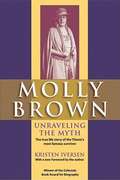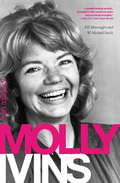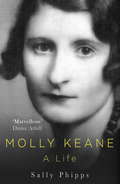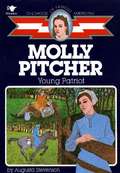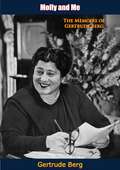- Table View
- List View
Mohamed's Ghosts: An American Story of Love and Fear in the Homeland
by Stephan SalisburyMohamed Ghorab had no hint one late spring morning in May 2004 that when he dropped his daughter off at school, his life would change forever. Federal agents and police surrounded him in front of terrified parents, teachers, and school children. They hustled him off to jail and eventually deported him. His wife, bewildered and astonished,was detained at the same time,. Moments later, agents raided the obscure Philadelphia mosque where Ghorab was imam, ransacking its simple interior and his house next door. Over the next several months, members of Ghorab’s congregation would be arrested and detained, interrogated and watched. Many would be deported. Others would flee the neighborhood and the country as their lives became riddled with rumor. Informants seemed to be listening everywhere. Husbands were separated from wives. Children were torn from parents. The mosque collapsed in a sea of debt and anxiety. The neighborhood lost something essential--trust and community. This was a jumpy and fearful time in the life of America following 9/11, as prize-winning reporter Stephan Salisbury well knew. But he did not anticipate the extremity of fear that emerged as he explored the aftermath of that virtually forgotten raid. Over time, the members of the mosque and the imam’s family gradually opened up to him, giving Salisbury a unique opportunity to chronicle the demolition of lives and families, the spread of anti-immigrant hysteria, and its manipulation by the government. As he explores events centered on what he calls “the poor streets of Frankford Valley” in Philadelphia, or the empty streets of Brooklyn , or the fear-encrusted precincts of Lodi, California and beyond, Salisbury is constantly reminded of similar incidents in his own past--the paranoia and police activity that surrounded his political involvement in the 1960s, and the surveillance and informing that dogged his father, a well-known New York Times reporter and editor, for half a century. Salisbury weaves these strands together into a personal portrait of an America fracturing under the intense pressure of the war on terror--the Homeland in the time of Osama.
Mohammed: The Man and His Faith
by Tor AndraeLong considered an essential survey of the origins, tenets, and substance of Islam, this biographical classic conveys a deep understanding of the Prophet and his faith. "Even today, after a period of development of thirteen centuries," author Tor Andrae notes, "one may clearly discern in genuine Islamic piety the uniqueness which is ultimately derived from its founder's personal experience of God." Andrae's fascinating profile of Mohammed's life and times encompasses the rich diversity of the Prophet's influence, exploring not only his impact on religion and history but also his political and social relevance.Beginning with an overview of Arabia in the sixth century, Andrae chronicles Mohammed's youth and the circumstances surrounding his prophetic call, offering a cogent analysis of his religious message and doctrine of revelation. The author discusses the conflicts surrounding the Prophet's early preachings that culminated in his flight from Mecca to Medina, where his leadership duties expanded to include the roles of politician, ruler, and military commander. In conclusion, an evaluation of Mohammed's personality offers insights into the everyday conduct that has served as a model to succeeding generations of Muslims.Comprehensive in scope and even-handed in perspective, this is one of the finest volumes available in English about Islam. Mohammed: The Man and His Faith is essential reading for students of religion, and its inspiring examination of Mohammed's deep piety and the power and spiritual energy of his religion will enthrall readers who are well versed in Islam as well as those unfamiliar with the Prophet's life and teachings.
Mohandas Gandhi (SparkNotes Biography Guide)
by SparkNotesMohandas Gandhi (SparkNotes Biography Guide) Making the reading experience fun! SparkNotes Biography Guides examine the lives of historical luminaries, from Alexander the Great to Virginia Woolf. Each biography guide includes:An examination of the historical context in which the person lived A summary of the person&’s life and achievements A glossary of important terms, people, and events An in-depth look at the key epochs in the person&’s career Study questions and essay topics A review test Suggestions for further reading Whether you&’re a student of history or just a student cramming for a history exam, SparkNotes Biography guides are a reliable, thorough, and readable resource.
Mohandas Gandhi: Essential Writings (Modern Spiritual Masters Series)
by John Dear Mohandas GandhiMohandas Gandhi (1869-1948) is widely acknowledged as one of the great souls of the twentieth century. As the leader of the Indian independence movement he defined the modem practice of nonviolence, wedding an ethic of love to a practical method of social struggle. In the end, however, his philosophy was rooted in a deep spirituality. For Gandhi the struggle for peace and social justice was ultimately related to the search for God. These writings reveal the heart and soul of a man whose life and message bear special relevance to all spiritual seekers.
Mohandas Gandhi: Spiritual Leader
by Diane CookGandhi's use of nonviolence to change his country inspired the world. His work to end 200 years of British rule in his home country of India changed the nation forever, but it also changed the way other people around the world fought for their freedom and human rights. Gandhi's ideas led great people from Martin Luther King, Jr. to the Dalai Lama to use nonviolence to work for change in their own countries. Today, Gandhi is remembered as one of the greatest leaders of all time. Learn about the story of one of the world's most important spiritual and political leaders in Mohandas Gandhi: Spiritual Leader.
Mohave Tattooing and Face-Painting
by Edith S. Taylor William J. WallaceMohave Tattooing and Face-Painting covers in detail the tattooing and face-painting practices of the Indigenous Mohave/Mojave people of the Southwest USA.“THE Mohave Indians of the lower Colorado River, like most primitive peoples, are fond of personal adornment. Two favorite methods of self-embellishment are tattooing and painting. Men and women have marks tattooed on the chin and usually on the forehead as well. Both sexes, in addition, paint striking designs on the face, hair, and body. The use of tattooing relates the Mohave to the California tribes, most of whom practise this art. Facial painting, except for ceremonial occasions, is not highly developed in California. The Mohave, who paint regularly, show more of an affinity in this trait to the Southwest where painting is elaborate and frequent. On the contrary, few Southwest tribes tattoo. It is noteworthy that tattooing and non-ceremonial painting occur together among the Mohave, as these traits are often regarded as mutually exclusive.”-Introduction.
Mohawk Saint: Catherine Tekakwitha and the Jesuits
by Allan GreerOn October 21, 2012, Pope Benedict XVI canonized Saint Kateri Tekakwitha as the first Native North American saint. Mohawk Saint is a work of history that situates her remarkable life in its seventeenth century setting, a time of wars, epidemics, and cultural transformations for the Indian peoples of the northeast. The daughter of a Algonquin mother and an Iroquois father, Catherine/Saint Kateri Tekakwitha (1656-1680) has become known over the centuries as a Catholic convert so holy that, almost immediately upon her death, she became the object of a cult. Today she is revered as a patron saint by Native Americans and the patroness of ecology and the environment by Catholics more generally, the first Native North American proposed for sainthood. Tekakwitha was born at a time of cataclysmic change, as Native Americans of the northeast experienced the effects of European contact and colonization. A convert to Catholicism in the 1670s, she embarked on a physically and mentally grueling program of self-denial, aiming to capture the spiritual power of the newcomers from across the sea. Her story intersects with that of Claude Chauchetière, a French Jesuit of mystical tendencies who came to America hoping to rescue savages from sin and paganism. But it was Claude himself who needed help to face down his own despair. He became convinced that Tekakwitha was a genuine saint and that conviction gave meaning to his life. Though she lived until just 24, Tekakwitha's severe penances and vivid visions were so pronounced that Chauchetière wrote an elegiac hagiography shortly after her death. With this richly crafted study, Allan Greer has written a dual biography of Saint Kateri Tekakwitha and Chauchetière, unpacking their cultures in Native America and in France. He examines the missionary and conversion activities of the Jesuits in Canada, and explains the Indian religious practices that interweave with converts' Catholic practices. He also relates how Tekakwitha's legend spread through the hagiographies and to areas of the United States, Canada, Europe, and Mexico in the centuries since her death. The book also explores issues of body and soul, illness and healing, sexuality and celibacy, as revealed in the lives of a man and a woman, from profoundly different worlds, who met centuries ago in the remote Mohawk village of Kahnawake.
Moi, je suis de Bouctouche
by Donald SavoieDonald Savoie a grandi dans un petit village acadien et est devenu un auteur et un universitaire accompli. Ses livres ont eu un effet profond sur les politiques publiques du Canada et sur l'administration du pays. Moi, je suis de Bouctouche n'est pas seulement l'histoire de Savoie lui-même, mais aussi une histoire qui porte sur le Canada, le peuple acadien et l'évolution du Canada français.
Moi, je suis de Bouctouche: Les racines bien ancrées
by Donald J. SavoieDonald Savoie a grandi dans un petit village acadien et est devenu un auteur et un universitaire accompli. Ses livres ont eu un effet profond sur les politiques publiques du Canada et sur l'administration du pays. Moi, je suis de Bouctouche n'est pas seulement l'histoire de Savoie lui-même, mais aussi une histoire qui porte sur le Canada, le peuple acadien et l'évolution du Canada français.
Moja vas nekoc
by Cristiano Parafioriti Tanja ČoprežGalati Mamertino, majhno gorsko središče, potopljeno v park Gorovja Nebrodi, kjer iz vsakega zidu pronicajo spomini pretekle dni: Moja vas nekoč nam pomaga podoživeti ravno delček teh spominov. Vse skozi pripovedi nam pisatelj živo predstavlja realne ljudi, opojne vonjave in stare okuse na osnovi opisov njegovega otroštva na Siciliji. Iz teh strani pronica tihi glas juga, ki ga duši topost vdanosti in otožnosti, ampak tudi ljubezen do preteklih časov, do krvave in revne zemlje, ki so jo izčrpale in ranile revščina, krivica in izseljevanje, ki pa še vedno živi v spominih odhajajočih ljudi. Vse to se vtisne v spomin in se zasidra v srce, ustvari čustveno gmoto, ki prekipeva in poplavlja v obliki besed, misli in podob nekega preteklega časa, dne ali trenutka ter še vedno vznemirja.
Mojo Hand: The Life and Music of Lightnin' Hopkins
by Timothy J. O'Brien David EnsmingerIn a career that took him from the cotton fields of East Texas to the concert stage at Carnegie Hall and beyond, Lightnin’ Hopkins became one of America’s greatest bluesmen, renowned for songs whose topics effortlessly ranged from his African American roots to space exploration, the Vietnam War, and lesbianism, performed in a unique, eccentric, and spontaneous style of guitar playing that inspired a whole generation of rock guitarists. Hopkins’s music directly and indirectly influenced an amazing range of artists, including Jimi Hendrix, Stevie Ray Vaughan, Miles Davis, John Coltrane, Tom Waits, and Bob Dylan, as well as bands such as the Grateful Dead, Jefferson Airplane, and ZZ Top, with whom Hopkins performed. Mojo Hand follows Lightin’ Hopkins’s life and music from the acoustic country blues that he began performing in childhood, through the rise of 1950s rock ’n’ roll, which nearly derailed his career, to his reinvention and international success as a pioneer of electric folk blues from the 1960s to the 1980s. The authors draw on 130 vivid oral histories, as well as extensive archival and secondary sources, to provide the fullest account available of the development of Hopkins’s music; his idiosyncratic business practices, such as shunning professional bookers, managers, and publicists; and his durable and indelible influence on modern roots, blues, rock ’n’ roll, singer-songwriter, and folk music. Mojo Hand celebrates the spirit and style, intelligence and wit, and confounding musical mystique of a bluesman who shaped modern American music like no one else.
Molecules of Emotion: The Science Behind Mind-Body Medicine
by Candace B. PertThe bestselling and revolutionary book that serves as a &“landmark in our understanding of the mind-body connection&” (Deepak Chopra, MD).Why do we feel the way we feel? How do our thoughts and emotions affect our health? In her groundbreaking book Molecules of Emotion, Candace Pert—an extraordinary neuroscientist who played a pivotal role in the discovery of the opiate receptor—provides startling and decisive answers to these and other challenging questions that scientists and philosophers have pondered for centuries. Pert&’s pioneering research on how the chemicals inside our bodies form a dynamic information network, linking mind and body, is not only provocative, it is revolutionary. By establishing the biomolecular basis for our emotions and explaining these scientific developments in a clear and accessible way, Pert empowers us to understand ourselves, our feelings, and the connection between our minds and our bodies—or bodyminds—in ways we could never possibly have imagined before. From explaining the scientific basis of popular wisdom about phenomena such as "gut feelings" to making comprehensible recent breakthroughs in cancer and AIDS research, Pert provides us with an intellectual adventure of the highest order. Molecules of Emotion is a landmark work, full of insight and wisdom and possessing that rare power to change the way we see the world and ourselves.
Molina
by Joan Ryan Bengie MolinaA baseball rules book. A tape measure. A lottery ticket.These were in the pocket of Bengie Molina's father when he died of a heart attack on the rutted Little League field in his Puerto Rican barrio. The items serve as thematic guideposts in Molina's beautiful memoir about his father, who through baseball taught his three sons about loyalty, humility, courage, and the true meaning of success. Bengie and his two brothers--Jose and six-time All-Star Yadier--became famous catchers in the Major Leagues and have six World Series championships among them. Only the DiMaggio brothers can rival the Molinas as the most accomplished siblings in baseball history. Bengie was the least likely to reach the Majors. He was too slow, too sensitive, and too small. But craving his beloved father's respect, Bengie weathered failure after deflating failure until one day he was hoisting a World Series trophy in a champagne-soaked clubhouse. All along he thought he was fulfilling his father's own failed dream of baseball glory--only to discover it had not been his father's dream at all. Written with the emotional power of sports classics such as Field of Dreams and Friday Night Lights, Molina is a love story between a formidable but flawed father and a son who, in unearthing answers about his father's life, comes to understand his own.
Molina
by Joan Ryan Bengie MolinaLa inspiradora y verdadera historia del pobre obrero de factoría puertorriqueño Benjamín Molina Santana, quien contra viento y marea crió a la mayor dinastía de béisbol de todos los tiempos. Los tres hijos de Molina--Bengie, José y Yadier--han ganado cada uno dos anillos de Serie Mundial, algo sin precedentes en ese deporte Uno de ellos, Bengie, narra su historia.Un libro de reglas del béisbol. Una cinta de medir. Un boleto de lotería. Esas cosas estaban en el bolsillo del padre de Bengie Molina cuando murió de un infarto cardiaco en el terreno surcado de Liga Infantil en su barrio de Puerto Rico. Ellas sirven como guías temáticas en la hermosa memoria de Molina sobre su padre, quien usó también el béisbol para enseñarles a sus tres hijos los principios de lealtad, humildad, valentía y el verdadero significado del éxito. Bengie y sus dos hermanos--José y Yadier, quien fue seleccionado seis veces para el juego Todos Estrellas--se convirtieron en famosos receptores en las Grandes Ligas y entre los tres han sido parte de seis equipos ganadores de Series Mundiales. Solamente los hermanos DiMaggio podrían compararse con los Molina como los más logrados hermanos en la historia del béisbol. Bengie era el que menos posibilidades tenía de llegar a las mayores. Era demasiado lento, demasiado sensible y demasiado pequeño. Pero ávido de ganarse el respeto de su querido padre, Bengie soportó fracaso tras fracaso hasta que un día logró alzar un trofeo de Serie Mundial en una casa club empapada en champán. Todo el tiempo pensó que estaba realizando el sueño glorioso de béisbol de su padre, sólo para descubrir que no había sido ese el sueño de su padre. Escrito con el poder emocional de obras clásicas sobre deportes, como Field of Dreams y Friday Night Lights, Molina es una historia de amor entre un formidable y a la vez imperfecto padre y un hijo que, al desenterrar respuestas sobre la vida de su padre, logra comprender las suyas propias.
Moll Cutpurse, Her True History
by Ellen GalfordSet in sixteenth century; very funny story about the adventures of a cross-dressing thief.
Molly
by Blake ButlerA gripping, unforgettable memoir from one of the best, most original writers of the 21st century. Blake Butler has changed the world of language with his mind-melting literary thrillers, and now he brings his abilities to bear on the emotional world."Terrifyingly intense and eerily spiritual ...The best book I&’ve read this year." —LOS ANGELES TIMES "A powerfully sad book ... Writers are often praised as 'fearless,' but Butler is not. In Molly, he makes fear his companion. That is the only way to write, and to live." —THE NEW YORKER "Shattering ... The result is a brutal yet beautiful look at the ravages of mental illness and the complexities of grief." —PUBLISHER'S WEEKLY &“I&’m not sure I&’ve ever been so totally consumed by any book—the way I was by Molly.&” —INTERVIEW "The most immediate feeling of life I've ever had reading a book—a life lived at the desk and out in the world, a life of openness and secrets. "Make art for me," Molly wrote to Blake. "I will read it all." I breathed along with every word." —PATRICIA LOCKWOOD "How to praise a book of such wounded beauty as Blake Butler's phenomenal Molly? The same way one would a life lost early: with love and sincerity and anger and wonder and lithely elegant and observant insights that remind us and inspire us, as Butler precisely does, to live and to love ourselves." —JOHN D'AGATA "Molly is a brilliant and brutal book. Blake Butler fearlessly takes on love and grief and the mysteries of this world and the next." —EMMA CLINE "A dark miracle—actual evidence that what we can never know, what we could never imagine about the one we love, is what binds us to them, beyond death." —MICHAEL W. CLUNE "I was gripped from the start by this memoir's urgent honesty. Blake Butler turned a story that was almost unspeakable into a narrative at once brutal and loving, broken and solid." —CATHERINE LACEY Blake Butler and Molly Brodak instantly connected, fell in love, married and built a life together. Both writers with deep roots in contemporary American literature, their union was an iconic joining of forces between two major and beloved talents. Nearly three years into their marriage, grappling with mental illness and a lifetime of trauma, Molly took her own life. In the days and weeks after Molly&’s death, Blake discovered shocking secrets she had held back from the world, fundamentally altering his view of their relationship and who she was. A masterpiece of autobiography, Molly is a riveting journey into the darkest and most unthinkable parts of the human heart, emerging with a hard-won, unsurpassedly beautiful understanding that expands the possibilities of language to comprehend and express true love. Unrelentingly clear, honest and concise, Molly approaches the impossible directly, with a total empathy that has no parallel or precedent. A supremely important work that will be taught, loved, relied on and passed around for years to come, Blake Butler affirms now beyond question his position at the very top rank of writers.
Molly Bannaky
by Alice Mcgill Chris K. SoentpietOn a cold gray morning in 1683, Molly Walsh sat on a stool tugging at the udder of an obstinate cow. When she spilled the milk, she was brought before the court for stealing. Because she could read, Molly escaped the typical punishment of death on the gallows. At the age of seventeen, the English dairymaid was exiled from her country and sentenced to work as an indentured servant in British Colonial America. Molly worked for a planter in Maryland for seven long years. Then she was given an ox hitched to a cart, some supplies-and her freedom. That a lone woman should stake land was unheard of. That she would marry an African slave was even more so. Yet Molly prospered, and with her husband Bannaky, she turned a one-room cabin in the wilderness into a thriving one hundred-acre farm. And one day she had the pleasure of writing her new grandson's name in her cherished Bible: Benjamin Banneker.<P><P> Jane Addams Children’s Book Award Winner
Molly Brant: Mohawk Loyalist and Diplomat
by Peggy Dymond LeaveyMolly Brant, a Mohawk girl born into poverty in 1736, became the consort of Sir William Johnson, one of the wealthiest white men in 18th-century America. Suspected of being a spy for the British during the American Revolution, Molly was forced to flee with her children or face imprisonment. Because of her ability to influence the Mohawks, her assistance was needed at Fort Niagara, and she found refuge there. A respected Mohawk matron, Molly became a vital link between her people and the Canadian Indian Department. Like her brother Joseph, she worked hard to keep five of the Six Nations on the side of the British throughout the war, believing the empty promises that all would be restored to them once the conflict ended. Although she was seen as fractious and demanding at times, her remarkable stamina and courage gained the respect of the highest levels of Canadian government.
Molly Brown from Hannibal, Missouri: Her Life in the Gilded Age
by Ken Marks Lisa MarksThe real story of the “unsinkable” Titanic survivor and her early life in the Midwest.In the film version of the life of the “Unsinkable Molly Brown,” she is rescued from the Colorado River and raised in the Rocky Mountains, but the actual Margaret Tobin Brown was born and raised in Hannibal, Missouri. Her formative years took place in the town’s Gilded Age; the railroad brought in lumber barons, and as the wealth of Hannibal grew, so too did the dreams of young Margaret, who would go on to fight for women’s rights, help build a cathedral, and more. Even though her future career as a philanthropist and socialite would span continents and she would become most famous for surviving the sinking of the Titanic, Molly Brown was always proud to be from Hannibal, and this is the true story of her life in the Midwestern town.
Molly Brown: Unraveling the Myth
by Kristen IversenWhen Margaret Tobin Brown arrived in New York City shortly after her perilous night in Titanic's Lifeboat Six, a legend was born. Through magazines, books, a Broadway musical, and a Hollywood movie, she became "The Unsinkable Molly Brown," but in the process her life story was distorted beyond recognition. Even her name was changed-- she was never known as Molly during her lifetime. Kristen Iversen's Molly Brown: Unraveling the Myth is the first full-length biography of this American icon, and the story it tells is of a passionate and outspoken crusader for the rights of women, children, mine workers, and others struggling for their voice in the early twentieth century. In the end, the real "Molly" Brown was far more fascinating than her myth, and Kristen Iversen has captured her in all her brilliance.
Molly Ivins: A Rebel Life
by Bill Minutaglio W. Michael SmithShe was a groomed for a gilded life in moneyed Houston, but Molly Ivins left the country club behind to become one of the most provocative, courageous, and influential journalists in American history. Presidents and senators called her for advice; her column ran in 400 newspapers; her books, starting with Molly Ivins Can't Say That, Can She?, were bestsellers. But despite her fame, few people really knew her: what her background was, who influenced her, how her political views developed, or how many painful struggles she fought. Molly Ivins is a comprehensive, definitive narrative biography, based on intimate knowledge of Molly, interviews with her family, friends, and colleagues, and access to a treasure trove of her personal papers. Written in a rollicking style, it is at once the saga of a powerful, pugnacious woman muscling her way to the top in a world dominated by men; a fascinating look behind the scenes of national media and politics; and a sobering account of the toll of addiction and cancer. Molly Ivins adds layers of depth and complexity to the story of an American legend-a woman who inspired people both to laughter and action.
Molly Keane: A Life
by Sally PhippsMolly Keane (1904 - 96) was an Irish novelist and playwright (born in County Kildare) most famous for Good Behaviour which was shortlisted for the Man Booker Prize. Hailed as the Irish Nancy Mitford in her day; as well as writing books she was the leading playwright of the '30s, her work directed by John Gielgud. Between 1928 and 1956, she wrote eleven novels, and some of her earlier plays, under the pseudonym M.J. Farrell. In 1981, aged seventy, she published Good Behaviour under her own name. The manuscript, which had languished in a drawer for many years, was lent to a visitor, the actress Peggy Ashcroft, who encouraged Keane to publish it.Molly Keane's novels reflect the world she inhabited; she was from a 'rather serious hunting and fishing, church-going family'. She was educated, as was the custom in Anglo-Irish households, by a series of governesses and then at boarding school. Distant and awkward relationships between children and their parents would prove to be a recurring theme for Keane. Maggie O'Farrell wrote that 'she writes better than anyone else about the mother-daughter relationship, in all its thorny, fraught, inescapable complexity.'Here, for the first time, is her biography and, written by one of her two daughters, it provides an honest portrait of a fascinating, complicated woman who was a brilliant writer and a portrait of the Anglo-Irish world of the first half of the twentieth century.
Molly Keane: A Life
by Sally PhippsMolly Keane (1904 - 96) was an Irish novelist and playwright (born in County Kildare) most famous for Good Behaviour which was shortlisted for the Man Booker Prize. Hailed as the Irish Nancy Mitford in her day; as well as writing books she was the leading playwright of the '30s, her work directed by John Gielgud. Between 1928 and 1956, she wrote eleven novels, and some of her earlier plays, under the pseudonym M.J. Farrell. In 1981, aged seventy, she published Good Behaviour under her own name. The manuscript, which had languished in a drawer for many years, was lent to a visitor, the actress Peggy Ashcroft, who encouraged Keane to publish it.Molly Keane's novels reflect the world she inhabited; she was from a 'rather serious hunting and fishing, church-going family'. She was educated, as was the custom in Anglo-Irish households, by a series of governesses and then at boarding school. Distant and awkward relationships between children and their parents would prove to be a recurring theme for Keane. Maggie O'Farrell wrote that 'she writes better than anyone else about the mother-daughter relationship, in all its thorny, fraught, inescapable complexity.'Here, for the first time, is her biography and, written by one of her two daughters, it provides an honest portrait of a fascinating, complicated woman who was a brilliant writer and a portrait of the Anglo-Irish world of the first half of the twentieth century.
Molly Pitcher: Young Patriot (Childhood of Famous Americans Series)
by Augusta StevensonA fictionalized biography of the childhood of the Pennsylvania German woman who became a Revolutionary War heroine when she carried water to American soldiers and even fired a cannon herself during the Battle of Monmouth.
Molly and Me: The Memoirs of Gertrude Berg
by Gertrude Berg Cherney BergIn these warm, happy memoirs of one of America’s most beloved radio, television, and stage stars, a woman who has delighted millions of people tells her own wonderful story, from the arrival of her grandfather in this country to her triumph in the Broadway hit A Majority of One.Her story really begins with Grandpa Mordecai Edelstein, who came to America, as she proudly explained to the grandchildren, before the Statue of Liberty.Young “Tillie,” as Gertrude Berg was called, grew up in a most engagingly alive family of brothers, sisters, parents, grandparents, aunts, uncles, and cousins in Manhattan’s upper East Side. “Home,” she says, “was an apartment on the fourth floor of a house you called an apartment house if you wanted to be fancy, and a tenement if you wanted to be depressing.”One day, her highly unpredictable father bought a hotel in the Catskills, a million-dollar mansion, for $500 and his word of honor, which was worth the difference. What with cocky bellboys, temperamental headwaiters, lovesick cooks, hungry musicians—and the guests, and the rain—every member of the family was busy. It became Gertrude’s job to entertain the fretful guests whenever storm clouds gathered, and as a result, she began to read palms. But she soon started writing playlets with parts for as many guests as possible. She remembers “with particular pride such masterpieces as ‘Snow White and the Twenty-eight Dwarfs’ and ‘Thirty-three Blind Mice.’”After such an education, radio was a natural step for her. Her own family (protesting loudly) became models for the famous radio family, The Goldbergs, which has captivated audiences for thirty years. Her experiences in the early days of radio, the transformation of The Goldbergs from radio to television, and her wonderful friendship with Sir Cedric Hardwicke, co-starring on Broadways with her, are all recalled with gusto, excitement, and pride.
